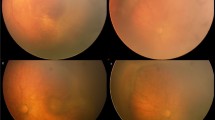Abstract
Purpose
To provide a diagnostic algorithm of recurrence and treatment failure after intravitreal bevacizumab (IVB) injection for retinopathy of prematurity type 1 (ROP1) and the stepwise therapeutic approach for both conditions.
Methods
Retrospective chart review of all patients diagnosed with ROP1 initially treated with IVB in 6 tertiary referral centers of Toluca and Mexico City from 2005 to 2017. Treatment failure was defined as persistence or progression of neovascularization, elevation of the ridge, worsening of plus disease, or retinal crunch within the first week after treatment. Recurrence was defined as the new appearance of plus disease, an elevated ridge, or pathological new vessels after an initial regression of ROP following treatment. Therapy was observation, switch of anti-VEGF agent, retinal photocoagulation, vitrectomy, or a combination of two or more, depending on the severity of findings.
Results
A total of 672 patients who received intravitreal bevacizumab injection for ROP1 treatment were included. Of these, 2.5% (17 patients) failed to treatment, 6.8% (46 patients) developed a recurrence for ROP, and 5.5% (37 patients) carried a misdiagnosis of recurrence and were diagnosed with other than ROP1 after examination. Based on the severity of findings, patients with recurrence or treatment failure were further treated by observation, repeat anti-VEGF intravitreal injection (bevacizumab or other), laser photocoagulation, vitrectomy, or a combination of these. Based on the treatment results, a therapeutic algorithm was created.
Conclusions
Intravitreal injection of anti-VEGFs for the treatment of ROP warrants close follow-up as some of these patients may have treatment failure or recurrence of the disease. It is crucial to differentiate between them to avoid a misdiagnosis and offer the correct treatment. We propose a novel algorithm for the follow-up and treatment approach of ROP1 following initial treatment with IVB. This algorithm offers a summary of our recommendations based on a large case series of ROP1 patients. It is meant to grow and expand as more clinical evidence becomes available.





Similar content being viewed by others
References
Sapieha P, Joyal J, Rivera JC et al (2010) Retinopathy of prematurity: understanding ischemic retinal vasculopathies at an extreme of life. J Clin Invest 120:3022–3032. https://doi.org/10.1172/JCI42142.The
Cavallaro G, Filippi L, Bagnoli P et al (2014) The pathophysiology of retinopathy of prematurity : an update of previous and recent knowledge. Acta Opthalmologica:2–20. https://doi.org/10.1111/aos.12049
Good WV (2004) Final results of the early treatment for retinopathy of prematurity (ETROP) randomized trial. Trans Am Ophthalmol Soc 102:1684–1694
Cryotherapy for Retinopathy of Prematurity Cooperative Group (2012) 15-year outcomes following threshold retinopathy of prematurity. Achives Ophthalmol 123:1–9
Coats DK, Miller AM, Hussein MAW et al (2005) Involution of retinopathy of prematurity after development of retinal detachment. Am J Ophthalmol 140:214–222. https://doi.org/10.1016/j.ajo.2004.12.106
Travassos A, Teixeira S, Ferreira P et al (2007) Intravitreal bevacizumab in aggressive posterior retinopathy of prematurity. Ophthalmic Surg Lasers Imaging Retin 38:233–237
O’Keeffe N, Murphy J, O’Keefe M, Lanigan B (2016) Bevacizumab compared with diode laser in stage 3 posterior retinopathy of prematurity: a 5 year follow up. Ir Med J 81:6
Mintz-Hittner HA, Kennedy KA, Chuang AZ (2011) Efficacy of intravitreal bevacizumab for stage 3+ retinopathy of prematurity. N Engl J Med 364:603–615. https://doi.org/10.1056/NEJMoa1007374
Yang X, Zhao Y, Wang Z, Lu L (2018) Effect of anti-VEGF treatment on retinopathy of prematurity in zone II stage 3 +. Int J Ophthalmol 11:641–644. https://doi.org/10.18240/ijo.2018.04.17
Karkhaneh R, Khodabande A, Riazi-eafahani M, Roohipoor R (2016) Efficacy of intravitreal bevacizumab for zone-II retinopathy of prematurity. Acta Opthalmologica 94:417–420. https://doi.org/10.1111/aos.13008
Pertl L, Steinwender G, Mayer C, Hausberger S (2015) A systematic review and meta-analysis on the safety of vascular endothelial growth factor (VEGF) inhibitors for the treatment of retinopathy of prematurity. PLoS One:1–16. https://doi.org/10.1371/journal.pone.0129383
Sankar M, Sankar J, Mehta M et al (2016) Anti-vascular endothelial growth factor ( VEGF ) drugs for treatment of retinopathy of prematurity. Cochrane Database Syst Rev. https://doi.org/10.1002/14651858.CD009734.pub2
Wong RK, Hubschman S, Tsui I (2015) Reactivation of retinopathy of prematurity after ranibizumab treatment. Retina 35:675–680
Martinez-Castellanos MA, Velez-Montoya R, Price K et al (2017) Vascular changes on fluorescein angiography of premature infants with low risk of retinopathy of prematurity after high oxygen exposure. Int J Retin Vitr 3. https://doi.org/10.1186/s40942-016-0055-6
Arriola-lopez AE, Martinez-perez ME, Martinez-castellanos MA (2017) Retinal vascular changes in preterm infants: heart and lung diseases and plus disease. J AAPOS 21:488–491.e1. https://doi.org/10.1016/j.jaapos.2017.08.004
Author information
Authors and Affiliations
Corresponding author
Ethics declarations
Conflict of interest
All authors certify that they have no affiliations with or involvement in any organization or entity with any financial interest (such as honoraria; educational grants; participation in speakers’ bureaus; membership, employment, consultancies, stock ownership, or other equity interest; and expert testimony or patent-licensing arrangements) or non-financial interest (such as personal or professional relationships, affiliations, knowledge or beliefs) in the subject matter or materials discussed in this manuscript.
Ethical approval
This article does not contain any studies with human participants or animals performed by any of the authors.
Informed consent
No informed consent was sought from patients in this study as only patient records that were accessible to medical professionals were obtained and collected for this study in a non-identifiable manner. In addition, no patient contact was required for this study, and outcomes for patients were not affected by the study due to its retrospective nature.
Additional information
Publisher’s note
Springer Nature remains neutral with regard to jurisdictional claims in published maps and institutional affiliations.
Rights and permissions
About this article
Cite this article
Martínez-Castellanos, M.A., González-H.León, A., Romo-Aguas, J.C. et al. A proposal of an algorithm for the diagnosis and treatment of recurrence or treatment failure of retinopathy of prematurity after anti-VEGF therapy based on a large case series. Graefes Arch Clin Exp Ophthalmol 258, 767–772 (2020). https://doi.org/10.1007/s00417-020-04605-y
Received:
Revised:
Accepted:
Published:
Issue Date:
DOI: https://doi.org/10.1007/s00417-020-04605-y




